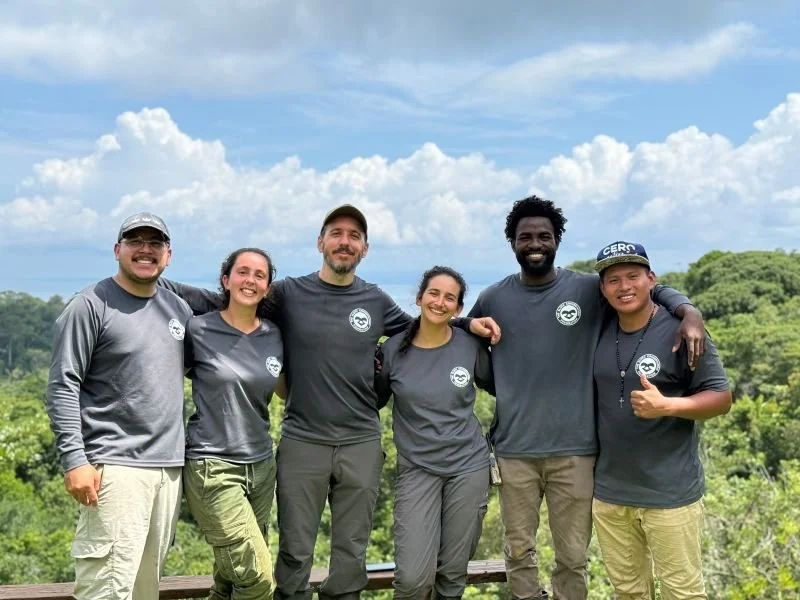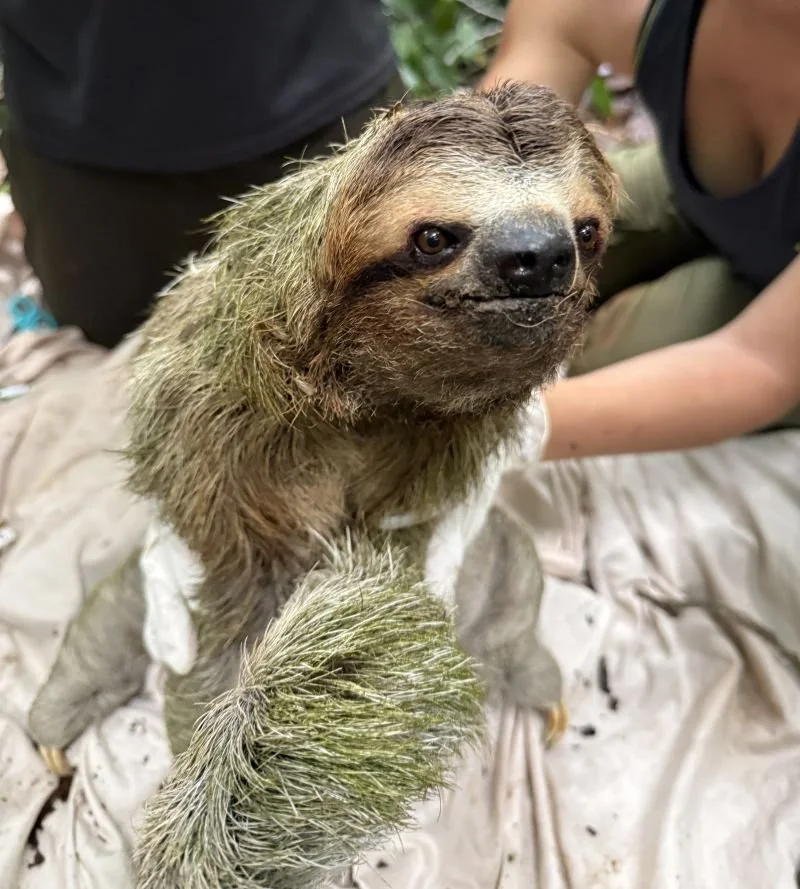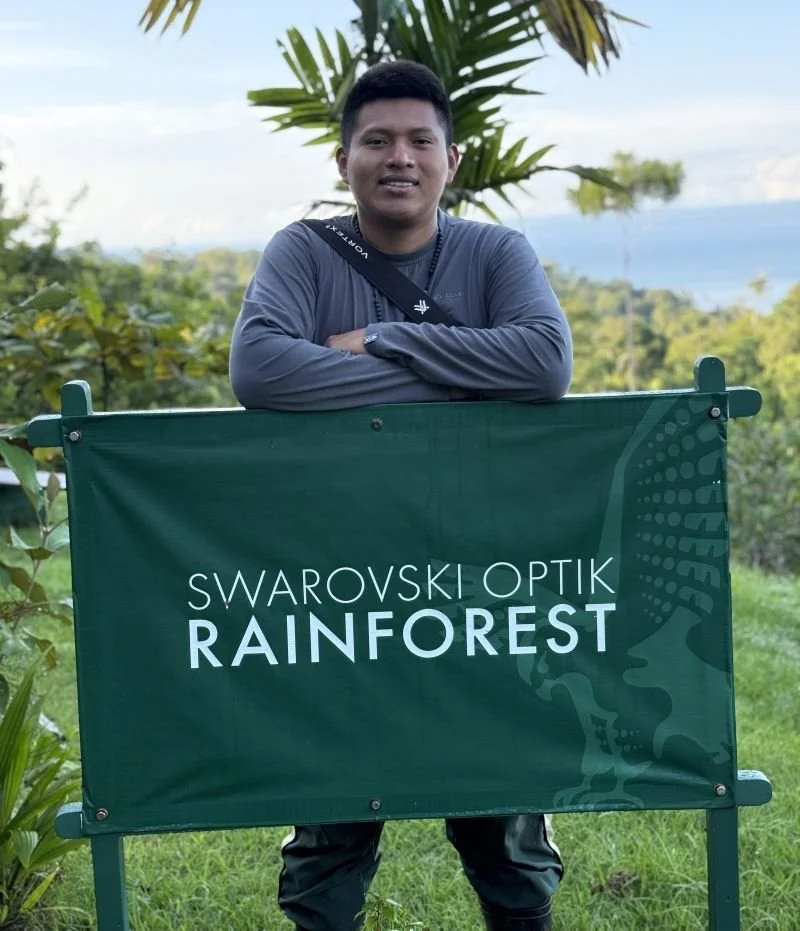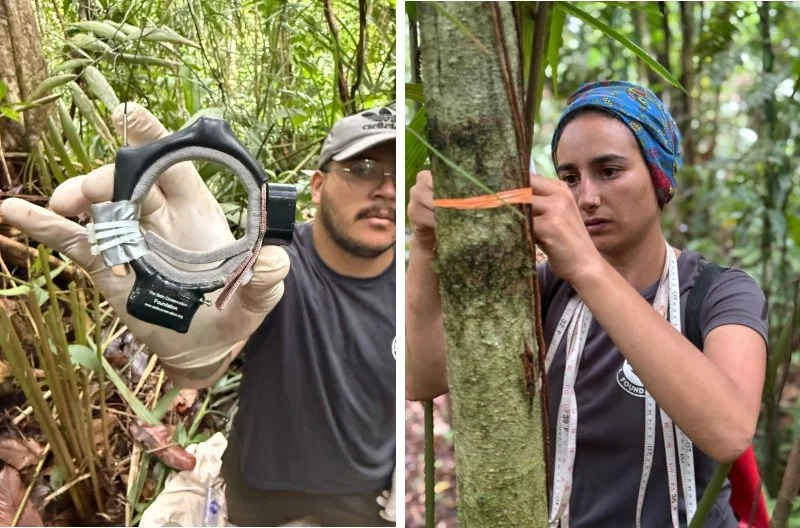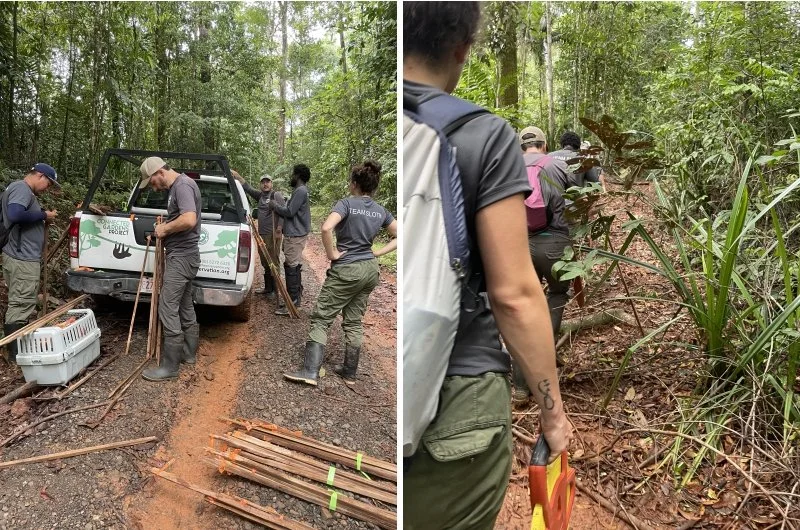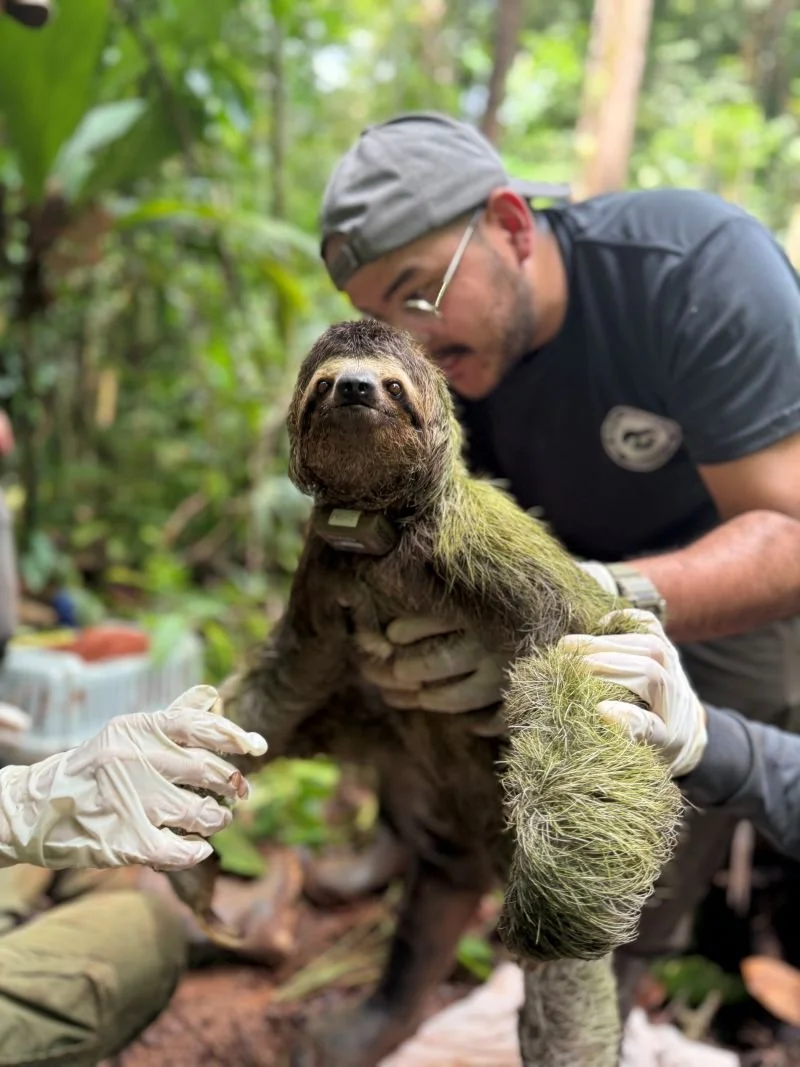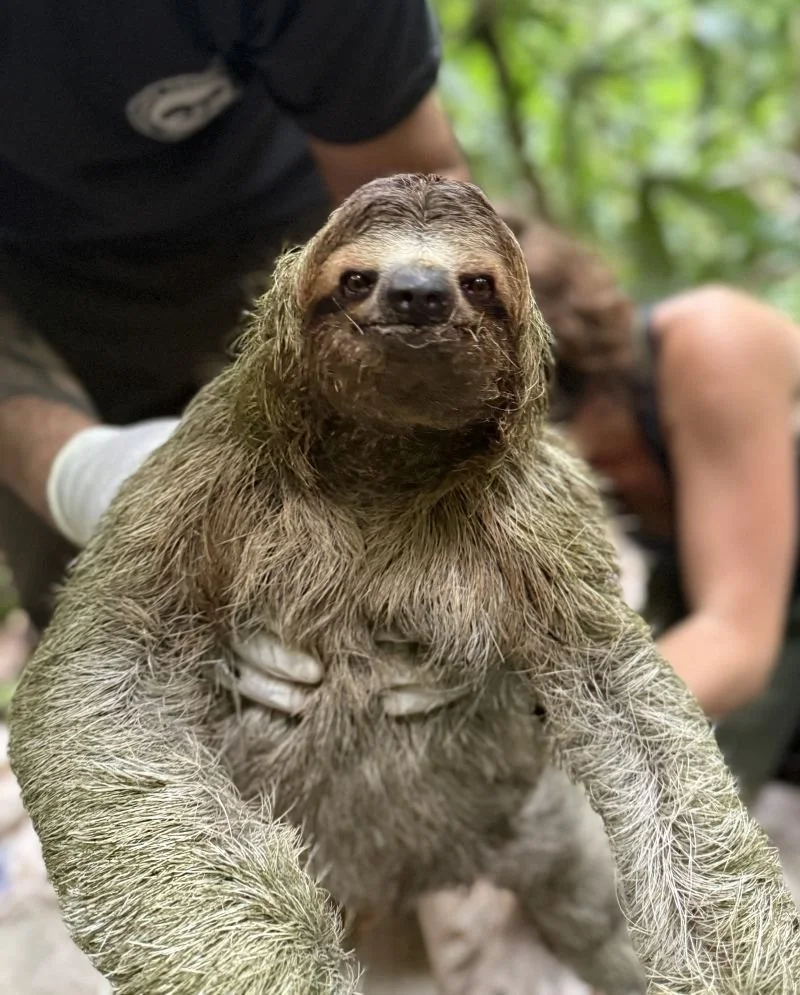Osa Expedition: Two Sloths, Three Plots, and One Very Happy Team
If there’s one thing fieldwork teaches you, it’s that nothing ever goes entirely to plan, and that’s exactly what makes it exciting.
At the end of August 2025, our team – led by researcher José Guzmán, along with Connected Gardens members Deily, Mariano, Dayber, and Diego, and joined by our newest volunteer, Shirley- embarked on a long-awaited expedition to the SWAROVSKI OPTIK RAINFOREST Reserve in Osa, Costa Rica.
This incredible property is located between Corcovado and Piedras Blancas National Parks and forms a vital wildlife corridor through one of the most biodiverse regions on the planet. Our mission was to carry out habitat surveys and count sloths for the Great Sloth Census, collar wild individuals in the pristine primary forest for the Urban Sloth Project, and assess the potential of the area for further sloth research and long-term conservation.
Day 0: The Journey Begins
We left our hometown, Puerto Viejo in the South Caribbean, at 3 AM. The drive across the country from east to west included a quick stop at Cerro de la Muerte (which means “Mountain of Death” in English), one of the highest peaks in Costa Rica. This area is known for its cold temperatures, ranging between 1°C and 13°C (34°F to 55°F), and its high-elevation ecosystems called páramos, characterised by grasslands and shrubs. It was refreshing to see such a different environment compared to the tropical rainforest we’re used to calling home.
Deily, Shirley, Mariano, Dayber, Diego, and José at Cerro de la Muerte.
We arrived at our accommodation at Mirador Osa Lodging by mid-afternoon, after a 12-hour drive, just in time to meet Terri and Gary, the SWAROVSKI OPTIK coordinators in Costa Rica. They gave us a full overview of the project and introduced us to Lesmes, the land’s caretaker and our guide for the week.
What is the SWAROVSKI OPTIK RAINFOREST?
Swarovski purchased 285 acres of primary rainforest in Mogos, an ecological link between two protected areas. Despite being near two national parks, this land plays an important role in connecting ecosystems for wildlife that move across larger territories.
Diego at the entrance of SWAROVSKI OPTIK RAINFOREST
This area is home to an incredible array of biodiversity, including frogs, bats, sea turtles, and even a recently discovered subspecies of sea snake. The nearby Golfo Dulce is one of only four tropical fjords in the world, and its waters support 25 species of dolphins and whales.
This reserve is a great place for research. Jose holding a Lotek GPS collar (left) and Deily flagging a tree for habitat surveys (right)
The mission of the SWAROVSKI OPTIK RAINFOREST is to protect this corridor from threats like poaching, illegal logging, and habitat degradation. Through long-term surveys and scientific research, the reserve hopes to understand the wildlife it supports and to assess whether endangered or locally extinct species can be reintroduced.
Setting the Scene
Over the next few days, we explored the property with Lesmes to choose locations for our Great Sloth Census plots. Flat areas are ideal for the team’s work, so we focused on more accessible sites. Along the way, we discovered a hidden waterfall just 200 meters from the shoreline, complete with a bench built by Lesmes. We also had a few surprise encounters with Terciopelos (both small and large), reminding us that Osa is as wild as it is beautiful.
Terciopelo or Fer-de-Lance (Bothrops asper) snakes, a baby and an adult.
We selected three plots for our work. One was close to the beach, another mid-elevation, and the third near the main road. Rainstorms and rough terrain were frequent challenges, but the team moved steadily forward, installing lines and conducting habitat surveys.
Waiting for Sloths
For days, we flew drones, walked transects, and scanned the canopy without seeing a single sloth. We spotted frogs, snakes, and birds, but the sloths remained elusive. Why is it so hard to spot sloths in one of the most biologically diverse regions of the planet? In a previous trip to Osa, Dr. Rebecca Cliffe wrote some hypotheses about this.
Although Osa is indeed a difficult place to find sloths, the spirits were still high, and the team was definitely hoping for a breakthrough. And then, on Day 6 of the expedition, it happened.
Not One, But Two Sloths
While surveying the third plot, Diego heard an unusual bird call and stopped to look. Just behind the bird, he spotted something moving: a three-fingered sloth, climbing quickly up a liana.
That was our moment. The team moved fast. Diego and José intercepted the sloth as it moved through a small tree, and Deily brought the equipment. Within minutes, we had placed a Telonics GPS collar and safely released the sloth into a tree that connected back to its original path. We named him Lesmes, in honor of the guide who helped us every step of the way.
Our first sloth at Osa: Lesmen! Pretty and green.
We were still watching Lesmes climb when something caught Dayber’s attention. Another sloth. At first, we thought we had lost sight of the one we had just collared, but the second sloth had no collar. It was a different individual.
This one was reachable too. We set the climbing line, retrieved the sloth, and fitted it with a Lotek GPS collar. By midday, we had two sloths collared, both healthy adult males. We named the second one Wilberth, and celebrated quietly under the canopy.
The handsome Wilberth.
It was an emotional moment for everyone. All the preparation, all the hiking, and all the waiting had paid off.
Final Days and Farewell
We finished our surveys on September 2 after one last day of walking transects and collecting habitat data. Then, right on cue, Osa sent us off with the heaviest storm of the week. Lightning struck nearby, and the rain poured through the restaurant’s roof. We waited it out with warm meals and card games, already thinking about the return trip.
Dayber, Deily, Jose, and Diego enjoying the views of Osa
What Comes Next?
Both GPS collars are programmed to record data until February 2026, when they will drop off automatically. We’ll return in March to retrieve them and repeat the sloth censuses in the same plots. In the meantime, we’ll be tracking movement data from Lesmes’ collar remotely.
This was just the beginning. The potential of this site for long-term sloth conservation is enormous, and we’re excited to keep building this partnership.
A huge thank you to the wonderful team at Mirador Osa Lodging, Restaurant & Bar for the warm meals, cozy cabins, and stunning views that welcomed us at the end of each long day. And to SWAROVSKI OPTIK RAINFOREST, thank you for your trust and support in helping us study and protect wild sloths in one of the most important conservation areas in the world.
We’ll be back soon, Osa.


